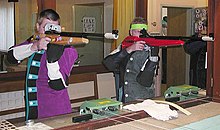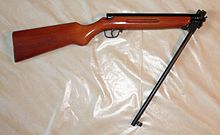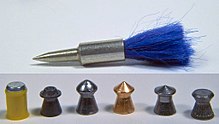Air rifle
Air rifles are rifles that propel a projectile through the expansion of compressed gas. In contrast to firearms , the pressurized gas is not generated by burning a propellant charge , but mechanically compressed inside or outside the weapon . Even weapons, where the bullet is driven by a gas other than air are to the pneumatic weapon counted. Various methods are used to provide the compressed gas.
Compared to handguns, air rifles are much less powerful and can hardly be used militarily. However, they are suitable for the practice of shooting skills and because of the low operating costs and the comparatively easy acquisition they are popular sports equipment.
history
For a long time now, compressed air weapons have been built by various inventors and gunsmiths. The earliest designs (around 250 BC) are those of the Greek engineer Ktesibios of Alexandria (around 285 to 222 BC), but there are few philological references to them. The oldest air gun dates from approximately 1580. As a sports equipment in the modern sense were air guns first in the United States in the aftermath of the American Civil War popular when they in shooting galleries ( " shooting galleries found") wide circulation. At the end of the 19th century, the Frenchman Paul Giffard patented the first CO 2 systems. In the past, air rifles were also used to a limited extent for military purposes (e.g. Girandoni wind rifle model 1780 ) and are now mainly used to hunt small food or crop pests, for entertainment (e.g. at fairgrounds ) and for competition purposes .
Operating principles
A basic distinction is made between single- loader air rifles and multi-loader air rifles . There are different technical solutions.
Systems with spring accumulators
A strong spring is tensioned before the shot and pushes a piston forward when the shot is triggered (comparable to an air pump). The air, compressed by the piston to up to 150 bar, drives the projectile. This principle is widespread in recreational weapons because the construction is simple and robust and there are hardly any costs except for the projectiles. In addition to a spring, the piston can also be driven by an air cushion that is compressed during tensioning ( gas ram system ). Similar to the systems with steel springs, the piston is driven forward by this air cushion when the shot is triggered.
In many recreational rifles, the barrel acts as a cocking lever for the spring (tilt or break barrel systems), on some models the cocking lever sits parallel below the barrel (e.g. Weihrauch HW 77 ). Other models have a tension lever on the side of the weapon housing (side tensioner, e.g. Haenel 312 , Feinwerkbau model 300 ); there were tension levers that resembled the loading levers of repeating rifles ("Durchlader", e.g. Haenel 310 , Anschütz model 275 ) and in early designs crank mechanisms were also used to tension the spring. A disadvantage of the spring-loaded system is the powerful bounce of the compression piston, which leads to significant jolts of the weapon when the shot is fired.
In order to reduce the bounce, the Dianawerk developed the double piston principle with the model 60 in the early 1960s , in which the bounce is almost completely absorbed by the use of two pistons working in opposite directions (working piston and empty piston). The system models 65 and 66 followed. The last model 75 equipped with this technology became extremely popular. Today's side tensioner model Diana 54 Airking is based on a different principle of shock absorption . Here the bounce is prevented by a spring-assisted return system, similar to the FWB models 150, 300 and 300S. However, these had the disadvantage that the system ran back about 2-3 cm when fired.
In the 1960s, the manufacturer Anschütz brought out its first shock-absorbing model with its 220 model. Here the system return is caught by an air cushion, in the successor model 250 (1972) by an oil-dampened cushion. Neither system was able to prevail against the competition from Feinwerkbau and Diana, although the return movement of the FWB models was prevented here by introducing the return system into another system (this carries the sights). These Anschütz models were only shock-absorbent. However, the bounce ultimately led to the extensive displacement of such systems by systems with compressed gas storage in the field of competition weapons.
Systems with gas pressure storage
In these systems, the compressed gas is provided by a pressurized gas container attached to the weapon. The gas is either compressed by means of a built-in pump before the shot or fed from an external container into the gun's pressure reservoir. In CO 2 systems a cartridge or cartridge with pressure-liquefied carbon dioxide attached to the weapon, which provides the pressurized gas. In all systems with compressed gas storage, a valve is briefly opened when a hammer fires, whereby pressurized gas acts on the projectile and drives it out of the barrel. Due to the low weight of the hammer, there are hardly any vibrations, and the compressed gas that is available enables a faster shot development than with spring-loaded systems.
CO 2 systems
In CO 2 systems from the cartridge is CO 2 conducted in a small pressure vessel. When firing, the bullet is propelled with the contents of this container. Subsequently, CO 2 flows from the cartridge into the container. Liquid CO 2 evaporates in the cartridge until the equilibrium pressure is restored. The pressure therefore remains constant as long as there is liquid CO 2 in the cartridge. This enables a constant firing energy, which is why this principle is also used with match weapons (weapons for sporty shooting with high precision, see also list of firearms technical terms ). A disadvantage is the temperature dependence of the pressure in the CO 2 cartridge, which can have a negative effect on the hit performance. Because there is no need to tension a strong spring and because they are easy to use, CO 2 systems are also used extensively in recreational weapons.
Compressed air systems
In systems for compressed air, there are on the one hand pump and compression systems in which the pressure is generated by a built-in hand pump, and on the other hand compressed air systems in which compressed air is filled from the outside into a compressed air tank in the weapon.
Pumping systems
Pump systems were already used in the historical wind rifles and were repeatedly used for recreational and hunting weapons. Usually an internal pressure tank is filled by a certain number of pump strokes, from which compressed air can then be taken for one or more shots. For example, the air reservoir of the Girandoni wind sleeve (1780) had to be filled with around 1500 pumps and then supplied compressed air for around 20 shots.
With compression systems , a single movement of the pump lever is enough to generate enough compressed air for one shot at a time.
Compressed air systems
Compressed air systems ( PCP for Pre-Charged Pneumatic ) are widespread in match rifles , in which air compressed from the outside is filled into a built-in compressed air reservoir from a compressed air cylinder. From this reservoir, air is fed via a pressure reducer into a smaller container, from which the compressed air for the next shot is taken. The pressure reducer keeps the pressure constant for each shot as long as the pressure in the main tank remains above the value set on the pressure reducer. Since the advent of compressed air technology around the turn of the millennium, these systems have dominated the scene at competitions and also changed the types of attack and shooting sequences, as shooters can make the rifle ready to fire again due to the easier loading process. In the leisure sector and for hunting purposes, these systems play a subordinate role, since the provision and handling of highly compressed air (200 to 300 bar) are comparatively complex.
Target facilities
Originally, an immovable rear sight and front sight were used for aiming air rifles . The rear sight consists of a rectangular U-shaped recess at the upper rear end of the rifle. The front sight is attached to the top edge of the barrel. When aiming, the top edge of the front sight must form a line with the top edge of the rear sight ("struck front sight"). This line must now be set below the ring area of a target (one speaks here of "letting the ring area sit down"). At the same time, the grain should be placed in the center below the ten on the target.
Modern competition weapons in shooting sports have more precise aiming devices. Back sitting on the gun a diopter , and sits forward on the barrel in a front sight is known as a front sight . Ring front sights are available in different sizes, depending on how much of the ring surface is to be covered on the target. You can have a colored insert in the middle to filter the light. A further development are ring front sight tunnels with adjustable irises, which allow the best setting to be selected for the respective conditions.
The shooter sees through the rear sight, which essentially consists of a housing with a pinhole. On the top of the rear sight and on the side there are rotary knobs, with the help of which the rear sight can be adjusted very finely in height and lateral position. The shooter must now center the ring mirror of the target in the center circle of the front sight and then center both circles in the sight opening of the rear sight. When the shot is triggered, the bullet lands in the ten on the target (as far as the theory).
Outside of shooting sports, telescopic sights are often used on air rifles in the leisure sector. In the case of articulated rifles, there is usually a variation in height if the barrel is not precisely locked. Riflescopes work optimally on air rifles with a fixed barrel and separate cocking lever, such as the HW77.
Shaft
Above all, match stocks must be individually adaptable to the shooter and the athlete should be given a free hand in setting not only their dimensions, but also their weight and balance. Today's shafts mostly consist of cast or CNC-milled aluminum , to which plastic attachments are then added. The barrel length, angle and opening of the butt plate can be infinitely adjusted, as can the lateral positioning and inclination of the cap. The jaw can be adjusted in all possible directions to a perfect sight by diopter to ensure and foresight. The handles can of course be tilted, rotated and moved lengthways to ensure satisfactory contact with the trigger , the setting of which can of course also be customized.
silencer
Optimal results are achieved with compressed air weapons (e.g. HW100) or CO 2 weapons. With spring piston systems, silencers are not quite as effective because the mechanical noise of the weapon is not reduced.
Legal situation in Germany
Silencers are equal to the firearms for which they are intended. This means that the silencer can be freely acquired for air rifles up to 7.5 J muzzle energy from the age of 18 and can be used on air rifles up to 7.5 J.
However, as with air rifles, self-construction is prohibited without a manufacturing permit in accordance with Section 21 (commercial) or Section 26 (non-commercial) of the Weapons Act.
Legal situation in Austria
In Austria, silencers are generally prohibited items under the Weapons Act and may therefore not be mounted on air rifles, regardless of their performance.
Calibers and bullets used
Diabolo
Air rifles are manufactured in various calibers and mainly fire bullets called " diabolos " . The most common caliber in sport shooting is 4.5 mm, the non-metric designation is .177 (0.177 inch ), other common diabolo calibers are 5.5 mm (.22), 6.35 mm (.25) and 5 mm (. 20).
The largest commercially available caliber worldwide in mid-2011 is .50. Corresponding weapons come mainly from South Korea and are sometimes used for hunting. The 7.5 J limit applicable in Germany for free sale is exceeded by appropriate weapon systems.
Round balls
In particular, so-called through - loading with magazine are mostly set up for round balls ("point balls") in caliber 4.4 mm, which are made from lead . Some leisure models shoot copper or aluminum-coated steel balls with a caliber of 4.5 mm. Such weapons are quite popular in English-speaking countries as BB guns . The barrels of these weapons usually have no rifling , which has a negative effect on the hit performance due to the lack of twist. Rifles for such bullets are therefore usually only shot at close range at fairground stalls.
Hairpin
For shooting at room distance at targets similar to a dart target , "spring" or "hair pins" are also used. Spring bolts consist of a pointed steel pin that is aerodynamically stabilized by a tuft of fibers on the back. The fibers are generally colored differently to identify the other players. Normal air rifles are unsuitable for using these bullets. Specially designed weapons are called bolt rifles. The steel body of the spring bolt can damage the barrel and thus impair accuracy, which is why spring bolts should only be fired from weapons designed for this purpose with a smooth (draft-free) barrel bore.
Arms legislation
Germany
In Germany, compressed air weapons up to a muzzle energy of 7.5 joules can be freely sold ( purchased ) to people aged 18 and over , provided they have the “F-im-Pünfeck” stamp. A gun license is a prerequisite for carrying compressed air weapons in public . The transport of a (packed) weapon that is not ready to fire and not ready to be accessed, e.g. B. to a rifle house or other shooting sports facilities, is a permit-free special form of leadership, also shooting on private property is permit-free, provided that the projectiles cannot leave a paved area, usually the property ( WaffG , § 12 (exception to permit requirements ), Paragraph 4, No. 1 lit. a). This only applies to "free" air guns. The minimum age for shooting with compressed air weapons in shooting sports in Germany is 12 years, with special permits also 10 years.
In order to acquire weapons with a muzzle energy higher than 7.5 joules, so-called long - range air rifles, a purchase authorization is required according to the Weapons Act (see weapon ownership card ). Information on this can be obtained from rifle clubs in Germany . However, this does not apply to air rifles that were manufactured and marketed on the territory of the former GDR before January 1, 1970 or April 2, 1991 (WaffG, Annex 2, Section 2, Subsection 2, No. 1.2 ); these can also be freely acquired and owned regardless of their muzzle energy or the presence of an "F-im-pentagon" stamp.
Austria
In Austria, air rifles with a caliber smaller than 6 mm fall under Paragraph 45 of the Weapons Act 1996 and are therefore exempt from many provisions, for example the reporting requirement. The Austrian Weapons Act does not provide for any limitation of the muzzle energy for air guns, these guns are freely available from the age of 18. The “F-im-Fünfeck” mark required in Germany is also not required. Air rifles with a caliber of at least 6 mm are subject to the provisions of the Weapons Act 1996 and are classified according to their design in the categories of the Weapons Act. Basically, you will find category C (long rifle with a rifled barrel that does not work semi or fully automatically) and is therefore notifiable. This means that they can still be purchased from the age of 18, but you must register with a gunsmith or arms dealer. Shooting with air rifles is possible on the property, provided that it can be guaranteed that no projectile leaves the property. People under the age of 18 are not allowed to handle air rifles outside of the shooting range, not even under adult supervision. In Austria, silencers are generally banned, this also applies to the free models for "F-im-pentagon" weapons that are widespread in Germany.
Switzerland
According to Art. 4 para. 1 let. f of the Weapons Act (WG) are “compressed air and CO 2 weapons which develop a muzzle energy of at least 7.5 joules or which can be mistaken for real firearms because of their appearance”. In principle, they are subject to the same rules as firearms, but may be acquired without a weapons acquisition license (Art. 10 para. 1 let. D WG). Other air rifles are not considered weapons and are therefore not subject to any regulation. You can get these weapons under the age of 18.
See also
Web links
Individual evidence
- ↑ Anschütz: adjustable iris ring front sight tunnel (online PDF) ( Memento from May 5, 2018 in the Internet Archive )
- ^ WaffG - Weapons Act. Retrieved November 3, 2017 .










